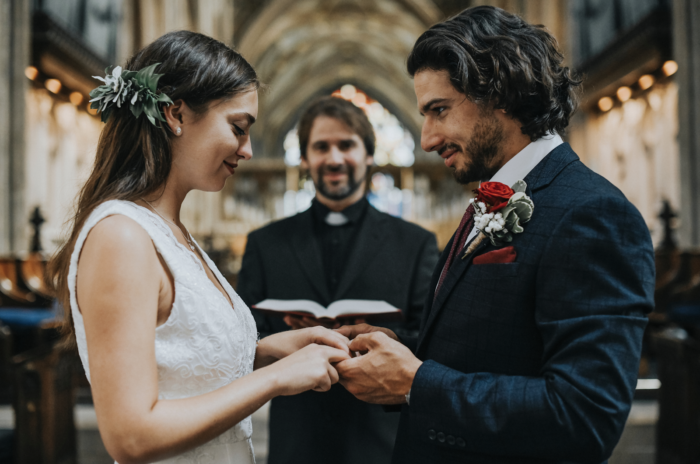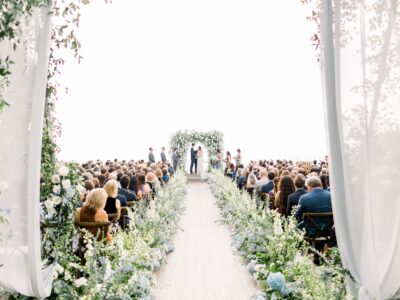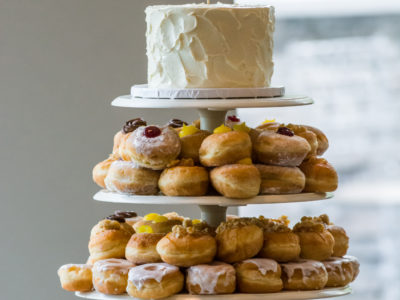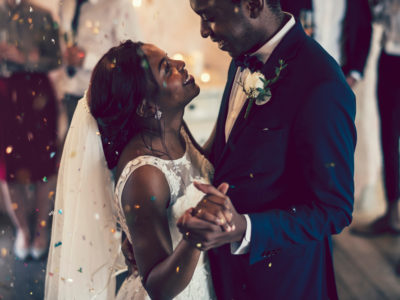Order Of Wedding Ceremony: How To Perfectly Structure A Traditional Wedding

Ready to create the perfect structure for your traditional wedding? We’ll help you sort through all the different segments of the celebration and the proper order of wedding ceremony.
Traditional weddings involve a sacred series of events that date back hundreds of years. The purpose of wedding ceremonies is to make a couple’s lifetime commitment to each other binding.
Every married couple before you, has gone through their own personal ceremony, whether it was traditional, religious, or otherwise. The traditional order of wedding ceremony differs depending upon one’s faith as does the traditional wedding processional order.
Interested in discovering the unique features of a variety of different wedding ceremonies? We’re here to take you through the traditional order of wedding ceremony and wedding processional order for Christian, Jewish, Islamic, Indian, and Interfaith weddings.
Quick Links
Traditional Christian Weddings
In Christianity, there are seven different religious ceremonies known as sacraments. Wedding ceremonies involve the sacrament of Holy Matrimony in which a man and a woman vow to be faithful to each other and their church.

Get The Best Wedding Hashtags From Professional Writers
Order nowThe Christian Order Of Wedding Ceremony
1. Processional
The processional hymn begins to plan, and the guests begin to enter the church in a specific wedding processional order. The groom’s grandmother is seated first followed by the bride’s grandmother, the groom’s parents, then the bride’s mother.
Traditionally, the family of the bride file into the pews on the left while the family of the groom take the seats on the right side of the church.
The Pastor and the groom enter from the side of the church. The wedding processional order begins with the Groomsmen escorting the Bridesmaids down the aisle, one by one. The Maid of Honor and Best Man follow. The Flower Girl walks down the aisle next, dropping flower petals along the way while accompanied by the Ring Bearer.
2. Giving Away The Bride
After the wedding party completes their processional, the congregation stands as the bride walks down the aisle, escorted by her father.
The Pastor now asks, “Who gives this woman to be married to this man?” The father will respond “I do” as he hands his daughter over to the groom as a symbolic display of love and support.
3. Prayers And Homily
The Pastor will begin the ceremony with opening prayers about the sacrament of Holy Matrimony. He will typically read a passage from the Bible and discuss its meaning and importance to the couple in his homily.
4. Singing Of A Hymn
Music is a very traditional aspect of Christian mass and ceremonies. Here, a hymn of the couple’s choosing is sung. A hymn book or a pamphlet given out prior to the ceremony will contain the song’s lyrics allowing all the guests to sing along if they please.
5. Wedding Vows
The wedding party moves to the platform as the bride and groom face each other. Here the couple exchange their written vows expressing their commitment to each other and their faith.
6. Exchanging Rings
The rings the ring bearer brought down the altar now come into play. The groom will put the wedding band on his bride while the bride will do the same for the groom. The rings are worn on the ring finger of the left hand.
The wedding band is an important wedding symbol. Its circular shape refers to the eternal love they share and the eternal length of their marriage.
7. Pronouncement
Here, the Pastor will announce that man and woman have become husband and wife in the presence of God and their witnesses.
The Pastor will typically lead the congregation in prayer, asking God to protect and strengthen this couple throughout their marriage.
8. The Kiss
As the official signifier that the couple has been wed, the Pastor will grant the groom permission to kiss his bride.
The Pastor will then officially present the newlyweds to the congregation for the first time as Mr. and Mrs. ______.
9. Recessional
The Christian wedding ceremony is now complete. The Bride and Groom are the first to exit the church. The Maid of Honor and Best Man are next to leave, then the rest of the Bridesmaids and Groomsmen, followed by the Flower Girl and Ring Bearer. All other guests are escorted out row by row.
Unique Features Of A Christian Wedding
There are many symbolic aspects of the Christian wedding ceremony. Traditionally, after vows and rings are exchanged there is a lighting of unity candles.
Flames and candles are a symbolic addition to Christianity. The Sanctuary lamp is an oil fueled candle placed near the Tabernacle which is kept alight as a reminder of God’s presence. Candles are also frequently lit in Christian churches for prayer, advent, sacraments, and to remember the deceased.
The lighting of the unity candle during a wedding ceremony also serves as a sacred tradition to feel the presence of God. It symbolizes the union between the couple as their separate candles become one flame as they light the unity candle together.
Traditional Jewish Weddings
The traditions of a Jewish wedding ceremony are all very purposeful with plenty of symbolic references to the structure and duties of one’s marriage.
The Jewish Order Of Wedding Ceremony
1. Ketubah Signing
Prior to the start of the wedding ceremony, it’s traditional for the couple and two witnesses to sign the ancient marriage document known as the Ketubah. This document is not religious, but rather a part of Jewish civil law. It lays out the commitments and duties of the groom to his bride while listing the bride’s rights as well.

Get The Best Wedding Hashtags From Professional Writers
Order now2. Bedeken
Immediately following the signing of the Ketubah is the ritual of Bedeken or the veiling of the bride. Here the groom places the veil over his bride to symbolize that their relationship is deeper than appearance.
It’s also a common tradition for the couple to not see each other for one week prior to their wedding. This veiling tradition can become quite emotional as it will be the first time the two have been together for seven days.
This ritual is also a reference to the Bible story in which Jacob is tricked into marrying the wrong woman because she was heavily veiled. The groom veiling his own bride is to ensure he doesn’t get tricked as Jacob had.
3. Processional To The Chuppah
With the first two rituals complete, it’s time for the wedding party and the parents to process to the focal point of the ceremony, the Chuppah. The Chuppah is a structure meant to represent the home, love, and protection that the couple are building with each other through marriage.
The wedding processional order is as followed: the Rabbi, the Groomsmen, the Groom escorted by his parents, the Bridesmaids, the Flower Girl and Ring Bearer, then the Bride escorted by her parents.
When the bride arrives at the Chuppah she circles her groom seven times. Seven is a sacred number throughout Jewish scripture. The act of walking in circles around the groom is meant to signify building a wall of love and protection around their life together.
4. Blessing Of Betrothal
The Rabbi will recite a blessing of betrothal, Kiddushin, which expresses the purpose of the ceremony and the commitment the couple has to each other as well as in creating a Jewish home together. Along with this blessing, the couple drinks from the first cup of wine.
5. Exchanging Rings
Here the wedding bands are exchanged as a signifier of the bonding agreement of their marriage. The wedding rings are traditionally plain bands without any further stones or embellishment. The simplicity of the rings symbolizes the simple beauty of marriage.
The traditional words “by this ring you are consecrated to me according to the law of Moses and Israel” are now spoken.
6. Sheva Brachot (The Seven Blessings)
These ancient blessings are recited to bless God their creator, as well as to pray for the happiness of the betrothed couple. After the Rabbi recites all seven blessings, the couple share a second cup of wine.
7. Breaking the Glass
As the ceremony concludes, the groom now stomps on a glass and breaks it to signal that it’s time to celebrate. The guests respond by shouting “Mazal Tov!” Everyone now processes out of the ceremony to begin the reception.
8. Yichud
While the rest of the guests have finished witnessing the wedding ceremony, the couple still have one more ritual to complete. Yichud means seclusion. This is an intimate moment where the newlyweds must reflect privately away from their guests to reflect on the ceremony and on their new marriage.
This is the first moment the couple is together as husband and wife and represents an important moment of privacy and reflection. Traditionally, this moment must last at least eight minutes before rejoining everyone back at the reception.
Unique Features Of A Jewish Wedding
With all the symbolism of a Jewish wedding, details become important. Even aspects such as the order guests process in and where the wedding party stands are details that make the ceremony meaningful.
As we’ve covered how the Chuppah represents the feeling of home and protection, the wedding party stands on either side of the structure to act as the walls of the home. This is a symbolic way to show how the couple’s closest friends and family are here to support and build their relationship up.
In some weddings, the Chuppah is a structure which physically relies upon the support of the wedding party as their friends must hold the structure up throughout the ceremony in a quite literal symbolic gesture.
Traditional Islamic Weddings
Islamic weddings are traditionally rather short and sweet ceremonies. While they typically last 20-minutes in length, the reception celebrations may go on well into the night. Despite its shorter length, these ceremonies are still rich in tradition.
The Islamic Order Of Wedding Ceremony
1. Tolbe
Prior to the wedding ceremony itself, the groom in question must ask the bride’s parents for permission to marry their daughter. This ritual is known as tolbe. Should the parents accept, all those present for the ritual will recite Surah-Fatiha which is a short prayer from the Quran.
2. Nikah
Nikah or katb Al-kitaab is the actual ceremony portion of the traditional Muslim wedding. If the ceremony is taking place inside a Mosque, guests must abide by certain traditions in order to respect this sacred place of worship.
The dress code for the wedding ceremony is conservative. One’s attire must be full-length to cover their arms and legs. Women are also traditionally expected to wear head covering. Before entering the mosque, you must also remove your shoes.
Once inside for the ceremony, it’s traditional for genders to be separated as males will be seated on one side and women on the other. Depending on the wedding, this separation may continue to the reception as well with a celebration in two separate rooms, a partition in one room, or a separation of genders by table.
3. Mahr
Mahr is the required payment the groom owes his bride. Traditionally, this payment is two installments: one prior to the wedding and one during the wedding ceremony. The purpose of this tradition is to provide a gift of value that symbolizes the groom’s love and respect towards his bride.
An engagement ring is typically considered the pre-wedding payment while a secondary symbolic gift is given on their wedding day.
4. “Qubool Hai”
The Imam, the officiant of the Muslim wedding, will now ask for the couple to agree to their commitment of marriage. Both the bride and the groom say “qubool hai” three times each in response, meaning “I agree.”
5. Nikah-Nama
The couple must now sign their official marriage contract in front of all their guests as witnesses. As part of the traditional ceremony, this contract is also read aloud in Arabic.
6. Reading From The Quran
While not necessarily required, it’s common for the ceremony to include a reading from the Islamic sacred text, the Quran.
Traditionally, Fatihah will be read which is the first chapter of the Quran. It serves as a blessing for the new couple. The Imam will follow up the reading with a short sermon interpreting its messages and its importance to the couple’s marriage.

Get The Best Wedding Hashtags From Professional Writers
Order now7. Savaqah
The ceremony concludes with a recessional tradition called savaqah. As the bride recesses out of the mosque or venue, the guests will shower her with coins to celebrate the marriage.
Unique Features Of An Islamic Wedding
Picking the right wedding date is an important part of an Islamic wedding. Al-qamar fil aqrab is the practice of avoiding ominous days for a wedding according to Muhammed the Prophet.
Days to avoid include Wednesdays, the last few days of a lunar cycle, days when the moon is in Scorpio, and other days of mourning or religious tragedies.
Avoiding these days are recommended for an ideal ceremony for a long and happy marriage.
Traditional Indian Weddings
Indian weddings typically consist of a few days of rituals and traditions, including pre-wedding ceremonies to bond with their future in-laws and pray for a safe wedding.
The Indian Order Of Wedding Ceremony
1. Tarik
This ceremony traditionally occurs one month prior to the wedding day. Here the groom’s offer to marry the bride will be officially accepted by her family. The bride’s male family member will offer the groom gifts and adorn his forehead with kumkum powder.
2. Barni Bandwhana
Fifteen days before the wedding the groom and his parents participate in this ritual. Mauli, a piece of thread, is tied around his and his parent’s wrists as they pray for a safe wedding.
3. Mayara
This next traditional pre-wedding ritual is known as the “Maternal Uncle Ceremony.” During this ritual the bride and groom’s maternal uncles travel to their sister’s house to present her with gifts. This typically includes the wedding attire they will wear to their child’s wedding.
4. Mehndi & Sangeet
One day prior to the wedding ceremony, these two rituals take place. Mehndi involves henna preparations as henna typically takes eight hours to dry. During the day professional henna artists will paint the bride’s skin. Henna is traditionally used to ward off evil and bring good luck to the marriage.
Sangeet is the nighttime celebration where friends, families, and guests of both sides meet and mingle together. At this point in the day, the bride’s henna should be dried and ready to join in on the celebration. The night typically involves sharing a meal and performing traditional dances.
5. Constructing The Mandap
The Mandap is the focal point of the ceremony where the official marriage commitment takes place. It’s a structure with four pillars which represent the four parents of the bride and the groom.
After the mandap is constructed the groom and his future mother-in-law meet here before the ceremony. The mother-in-law washes the groom’s feet and offers him milk and honey. During this time the bride’s sister attempts to steal his shoes. If she succeeds, the groom must pay her to get his shoes back.
6. Baraat
It’s finally time for the ceremony to begin as the groom makes his grand entrance. Traditionally, the groom arrives on a decorated white horse. His family and friends will follow him in while singing and dancing around him.
7. Processional
The wedding processional order of an Indian wedding begins with the elders escorting the groom to the mandap after his entrance. He must remove his shoes before being seated.
The parents of both sides also process up to the mandap. The bride is escorted by her uncle and brought to the center of the mandap with her significant other. Once united, the bride and groom each place floral garlands or Varmala around each other’s necks.
At the center of the altar is a ceremonial fire pit. Fire is an important aspect of Indian weddings as Agni the god of fire is said to give life. Once all have processed in, the bride’s brother gives the couple rice to throw into the fire to symbolize a lifelong marriage.
8. Mangal Phera
This next tradition involves walking around the fire. The couple will both circle the fire pit four times. Each time is to represent a major goal of their marriage including morality, prosperity, personal gratification, and spirituality.
The Pandit, the officiant of the wedding will chant verses during this time which officially weds the couple in the eyes of the gods.
After the couple completes their fourth circle, it’s tradition that they race back to their seats. It’s said that whoever sits down first will be the most dominant within their relationship.
9. Kumkum Powder
The ceremony is now complete. The groom will rub kumkum powder on his bride’s forehead and put a black and gold beaded necklace known as mangalsutra around her neck.
Unique Features Of An Indian Wedding
As you can see, the traditional Indian Wedding ceremony is not confined to a day, but rather consists of multiple ceremonies and rituals spread out for multiple days of preparation and celebration.
The traditions however do not end once the ceremony is complete. One day after the wedding is the tradition of Bou Bhat. In this ritual the groom’s family officially invites the bride to their home to accept her into their family. The groom pledges to support his new bride with food and clothing by presenting her with a new sari and a homemade meal.
Not all guests are invited to all days and segments of an Indian Wedding. Typically, the wedding invitation will specify which traditions each guest is invited to.

Pro Tip: The wedding invitation is an excellent place to include your wedding hashtag to help you keep all the memories of your multi-day celebration organized online.

Gift Yourself Your Dream Honeymoon
Sign up and register today for a free honeymoon registry!
Get StartedTraditional Interfaith Weddings
An Interfaith wedding is for couples coming from two different religious backgrounds and wishing to encompass both faiths into their wedding ceremony.
Depending upon you and your partner’s religions, there are many ways to creatively incorporate your two faiths into one beautiful ceremony. For a traditional order of wedding ceremony, here is a structure to consider.
The Interfaith Order of Wedding Ceremony
1. Processional
The wedding processional order may differ depending upon one’s religion; nevertheless, the processional typically is the signifier that the ceremony has begun. Traditionally, the bride should be the last to process in and the parents should play an important role by handing off their child to be married.
2. Opening Prayers & Readings
Open up your ceremony with an opening prayer or reading from both of your religions. No matter what your faith may be, there are sacred texts that are typically read during weddings. Have the officiant recite these significant blessings whether they’re from the Bible, Torah, Quran, or other sacred text.
3. Acknowledgement of Different Faiths
Each faith has their own specific wedding rituals. Acknowledge the commonalities and differences between you and your significant other’s faiths during this segment of the ceremony.
Take this moment to acknowledge that your marriage is a commitment to your partner and both your faiths.
4. Symbolic Blessing
Before the marriage is official, perform a symbolic ritual that represents blessing your relationship and your union as a couple. Use significant symbols from your two faiths to accomplish this.
This could include reciting a blessing while sharing a cup of wine as in Jewish tradition. It could involve fire such as the tradition of lighting the unity candle in a Christian wedding or tossing rice into the fire according to Indian tradition. It could even include an offering of a gift of sorts as representative of the Mahr of Islamic tradition.
5. Wedding Vows
Now it’s time to read your written vows to each other. Announce in front of all your guests your commitments to each other and to your faiths. Whether wedding vows or an official marriage contract is part of your religions, now is the perfect time to acknowledge your official commitment.
6. Exchanging Rings
Rings are a common wedding tradition among many different religions and cultures. Showcase your eternal agreement to share your lives together by exchanging rings.
7. Pronouncement
Once the rings are exchanged the marriage is solidified. Wrap up your interfaith wedding with a closing prayer or blessing recited by the officiant to wish you a long and successful marriage.
The officiant may now pronounce you husband and wife and you can share your first kiss as a married couple together.
8. Recessional
With the closing of the wedding ceremony, you can now recess out of the venue. Here is another opportunity to incorporate different traditions from your different faiths.
This could include breaking a glass as is traditional in a Jewish wedding. The guests could throw rice as the bride and groom exit as a sign of prosperity, fertility, and good fortune for the newlyweds. Or as in Islamic tradition, guests could throw coins at the bride as well.
Unique Features Of An Interfaith Wedding
The unique aspect of an interfaith wedding is that they are all unique. Interfaith weddings are the chance for the bride and groom to create their own ceremony while still relying on the underlying wedding traditions of their chosen faiths.
The order of wedding ceremony for an interfaith wedding is truly up to you and your significant other. While there is a general order to how a wedding ceremony progresses, you can combine the order of wedding ceremony of your two faiths to create something new and unique to you two as a couple.
Time To Structure The Reception
Now that you know the perfect order of wedding ceremony and wedding processional order for your upcoming wedding, it’s time to start planning the after party.
Receptions are yet another celebration filled with various religious and cultural traditions involving food, dances, table settings, the throwing of the bouquet, and more.
Oftentimes the wedding party will be announced as they arrive at the reception. Much like the wedding processional order, there may be specific traditions as to the order guests enter the reception.
While planning out this celebration, don’t forget to have some fun with it. Get a wedding hashtag and display it around the reception to encourage your guests to share your big day on social media and beyond.
If you need help coming up with the best wedding hashtag, let the professional writers at Wedding Hashers help you out!
#WeddingExperts
Wedding Hashers has industry experts who share their tips with you for free! Sign up to have their wedding expertise delivered right to you.



